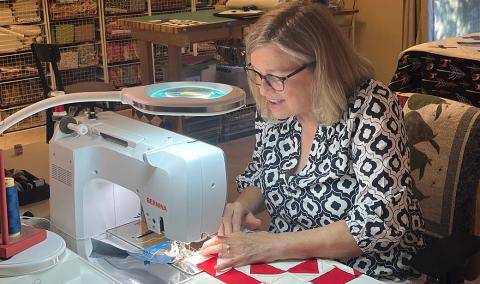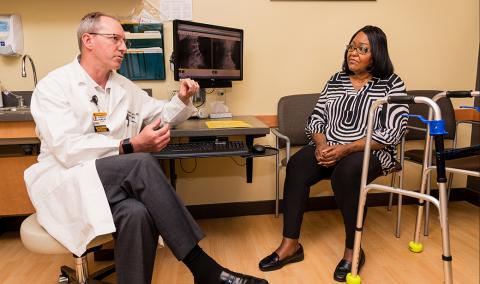Your neck pain can be the result of a common injury or, less likely, a medical condition. Thankfully, neck pain can get better with simple treatments or minimally invasive procedures. At MU Health Care, we can provide the expert care you need to manage pain and restore your mobility.
If you're experiencing neck pain, you're not alone. About one in three people experience neck pain at least once a year. Whether you slept wrong or have an underlying health condition, neck pain can greatly affect your daily life all the same.
At MU Health Care, our team of experts is committed to helping you find relief from neck pain.
What Does Neck Pain Feel Like?
When you have neck pain, you may experience:
- Stabbing or burning pain
- Shooting pain, traveling from your neck to your shoulders, arms or down to your hands
- Stiffness
- Restricted range of motion when turning your neck or tilting your head
- Headache
Causes of Neck Pain
There are many possible causes for your neck pain. The most common causes are muscle strain or tension brought on by daily activities, including:
- Poor posture, especially when working at a desk
- Sleeping in an awkward position
- Jerking or twisting your neck quickly, especially while exercising
- Accidents or falls that result in severe neck injuries, like whiplash
Medical Conditions That Cause Neck Pain
- Chronic arthritis: A long-term stiffness and tenderness in your neck joints.
- Fibromyalgia: A long-term, or chronic, health condition that results in widespread pain throughout your body.
- Herniated disk: A protrusion or severe bulging of the cushioning between the bones in your spinal column.
- Infections: Certain infections may cause neck pain, like meningitis.
- Spinal fractures: The type of fracture likely results from osteoporosis, which means your bones become weak and brittle.
- Spinal stenosis: A narrowing of the spinal canal surrounding your spinal cord.
- Tumors: Neck pain can be a symptom of a cervical spine tumor.
Considering the various causes of neck pain, it's important to get a proper diagnosis and appropriate treatment.
How We Diagnose the Cause of Neck Pain
At your first appointment, our team will:
- Go over your medical history.
- Conduct a physical exam to evaluate the alignment of your head and neck. This may involve observing your range of motion as you move your neck.
- Order imaging tests, such as X-rays or MRI scans, if we think you have a severe injury or medical condition.
How We Treat Neck Pain
At MU Health Care, our goal is to provide neck pain relief and improve movement. Oftentimes, we can help you find relief with medication. However, if your pain continues, our team can work with you to find a more effective nonsurgical or surgical treatment option.
Nonsurgical Treatments for Neck Pain
- Chiropractic care: Adjustment procedures offer pain relief while helping to improve neck motion and physical function.
- Physical therapy: A set of exercises is designed to strengthen the muscles in your neck and back while improving posture. These improvements can reduce pressure on your nerves and help relieve pain.
Our spine experts also offer more advanced nonsurgical treatments and use minimally invasive techniques whenever possible. This reduces your recovery time and allows you to return to your daily life faster. These include:
- Injection therapy: Medication is delivered directly to the area of your pain. We provide injections that provide relief for at least a few days, if not a year or longer. Types of injections include Botox, epidural and nerve blocks.
- Neurostimulation: A device, about three inches in size, is implanted under your skin, usually near your stomach or upper buttocks. This device sends mild electrical signals near your spine to disrupt pain signals to your brain.
- Radiofrequency ablation (RFA): Extreme heat is used to break down nerves sending pain signals to your brain.
Neck Surgery
- Anterior cervical arthroplasty: During an arthroplasty, one of our skilled spine surgeons will replace a damaged cervical disc, or spongy cushion between your vertebrae, with an artificial one. This approach preserves motion in the neck and can be an alternative to fusion.
- Anterior cervical corpectomy and fusion: Our spine surgeons will remove one or more vertebral bodies and the discs between them to relieve pressure on the spinal cord or nerves. They’ll then stabilize the spine by fusing the remaining bones together.
- Anterior cervical discectomy and fusion (ACDF): During this procedure, one of our experienced spine surgeons will remove the disc between your affected vertebrae. They will then fuse, or unite, the adjacent vertebrae.
- Laminectomy (with or without fusion): During a posterior cervical laminectomy, your lamina, the bony arch of your upper vertebrae, is removed to relieve the pressure on the spinal cord and nerves.
- Posterior cervical foraminotomy: Through a small incision, our skilled spine surgeon uses a powerful microscope to better see and remove lamina to alleviate pressure on a nerve. This can be done while maintaining stability of the spine without fusion.
- Posterior cervical laminoplasty: Our spine surgeons carefully reshape or "hinge" the lamina, the bony arch of the vertebra, relieving pressure on the spinal cord by widening the spinal canal while maintaining stability in the neck.
Preventing Neck Pain
Preventing neck pain often involves making simple lifestyle changes and maintaining good habits:
- Practice good posture, especially when working at a desk.
- Incorporate neck stretches into your exercise routine to improve posture and reduce strain.
- Sleep on your back or side, rather than your stomach, to prevent unnecessary pressure on your neck.
- Don’t smoke, as smoking can worsen the disc degeneration that can lead to early onset of neck pain.



























